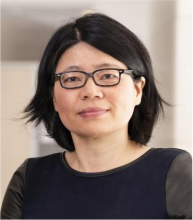Precise Solutions
Artificial intelligence (AI) is often touted as the solution to countless challenges across industries. But for Rong Xu, PhD (GRS ’99, biology), the potential of AI lies not in its broad application, but in its precision.
The bioinformatics professor’s strategy is a departure from the traditional “hammer and nail” mentality that pervades much of AI-driven research. Rather than developing algorithms first and seeking problems to solve, her team begins with pressing biomedical questions—whether understanding the underlying mechanisms of a disease, discovering new drugs or assessing public health policies—and specifically crafts AI tools to answer them.
Xu’s fascination with AI is fueled by the unprecedented data now accessible to researchers, from genetic and genomic information to cellular and patient-level data—and even population-level trends. For instance, in recent studies on semaglutide—a drug used for diabetes and obesity through products such as Ozempic and Wegovy—Xu’s team analyzed vast amounts of data and revealed its potential to reduce Alzheimer’s risk and ad- dictions such as alcohol use and smoking, among many other headline-making connections.
In the future, Xu believes AI will continue to unlock new insights from complex datasets, leading to more innovative treatments and better health outcomes.
“There are so many emerging problems—environmental health, pandemics, the opioid epidemic—where our understanding is still limited,” she explained. “AI will continue to play an increasingly important role in tackling these challenges, helping us to better understand diseases, discover new treatments and, ultimately, improve human health and well-being.”
Fighting Resistance
Jacob Scott, MD (MED ’08), is using AI to tackle one of the toughest challenges in medical science: drug resistance. In his lab, AI is more than a tool—it’s a game-changer.
An associate professor of molecular medicine, Scott is on a mission to understand and combat drug resistance in cancer and pathogens—an intricate process characterized by countless variables and unpredictable outcomes.
“As a laboratory studying the evolution of drug resistance, we are often faced with incredibly complex, high-dimension data that changes over time,” Scott explained. “As cancers and pathogens evolve resistance, they change in shape and mutate, gaining new properties.
Scott’s laboratory team employs AI to simplify and analyze vast amounts of genomic data, a task that would otherwise be overwhelming for traditional methods, such as manual data sorting and data visualization. By developing advanced optimization algorithms, his team aims to slow down or even reverse the troubling trend of resistance evolution. In a recent study, Scott and his colleagues found that interactions between resistant and non-resistant cells may explain how resistance survives in diseases like cancer, pathogens and parasites.
“In a world where the tools we have for data science and analysis are increasingly less able to handle the data types we are able to measure,” he continued, “we are leaning more and more on AI methods to help bridge the gap.”
Like all fields, Scott expects AI to continue to disrupt the way we approach healthcare.
“We are just now learning to incorporate the power of AI into our daily lives, and it is difficult even to imagine where that will take us in the coming years,” he said.
Imaging Insights
Imagine a future where AI not only complements physicians’ expertise but transforms medical care by analyzing complex data, predicting disease progression and guiding personalized treatments. Satish Viswanath, PhD, associate professor of biomedical engineering, leads a lab at the forefront of this revolution.
Viswanath and his team are creating AI algorithms that decode complex medical images (magnetic resonance imaging, computed tomography and positron emission tomography scans) in an effort to revolutionize how diseases are diagnosed and treated. By examining detailed images of tissues or organs, Viswanath’s algorithms can identify biomarkers that indicate how a disease is likely to progress or respond to a particular treatment. This capability is crucial for enabling the tailored treatments of precision medicine. At present, Viswanath is using the technology to improve rectal cancer treatment.
Viswanath’s team has further examined how to account for differences between sites, scanners and acquisition parameters to ensure generalizable performance of AI tools and computational imaging features—crucial for broader clinical translation and widespread adoption.
“We are just scratching the surface with regard to the potential of AI in the field of medicine,” said Viswanath. “AI technologies are relatively nascent in terms of what kinds of problems they are being applied to and the types of information we have been able to extract from medical data.



